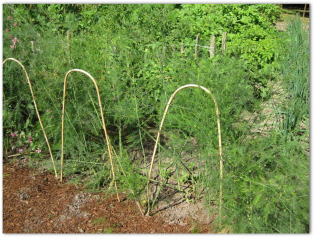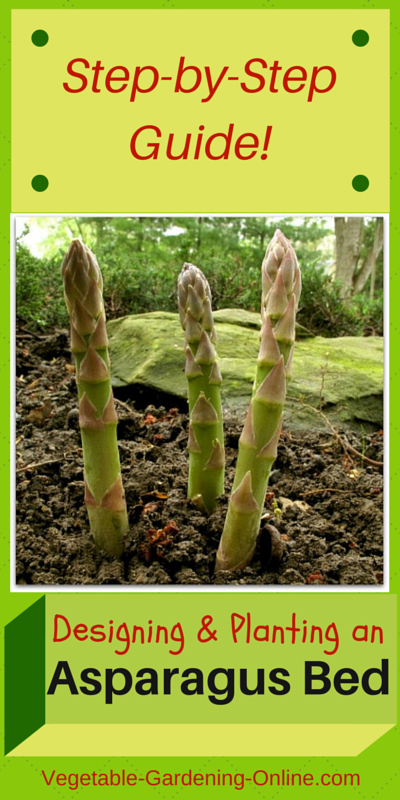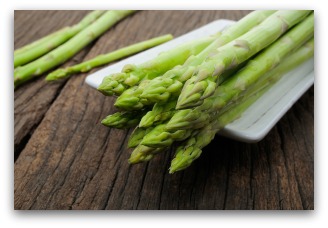How to Plant Asparagus
in Your Backyard Garden
Use our easy tips on how to plant asparagus in a backyard vegetable garden!
Learn all about growing, caring for, and harvesting asparagus plants fresh from your garden.
Create Your Own Free Square Foot Garden Or Planting Guide
Asparagus is a member of the fern family.
The stalks that are eaten are actually young shoots that will turn into a frond if not harvested promptly.
Shoots should be harvested when they are about the height of your hand.
Download Free Garden Planning Worksheets, Garden Diary, Zone Chart, Or Planting Guide
About Planting Asparagus
The success achieved when growing asparagus is in direct proportion to the care taken in preparing the soil.
Asparagus matures very slowly.
It takes three years from seed to first light harvest.
Planting seed in the garden is taking the longest possible route to fresh homegrown asparagus.
Most gardeners begin planting the crops in May.
Cut a full year off the maturation time by planting one year old roots.
Two year old roots are also available but many gardeners prefer the younger ones.
When the two year old roots are dug from the nursery bed, so much of their structure is left behind that they are slow to recover from the shock of relocation.
How to Grow Asparagus
Building an Asparagus Bed
When building an asparagus bed, keep in mind that growing asparagus roots need a thick layer of soil protection from the elements and the hazards of cultivation.
How to plant asparagus:
Step 1. Dig a trench a foot deep and 18 inches wide.
Leave a distance of 4 feet, center to center, between the trenches, if planting more than one row of asparagus.
Step 2. At the base of the trench, break up the soil to the depth of a spading fork, around 8-10 inches.
Step 3. Add ½ pound of 10-10-10 fertilizer to each 10 foot stretch of trench in your asparagus bed.
How to plant asparagus--soil preparation in an asparagus bed:
Asparagus thrives in neutral soil, with a pH of about 7.0.
If a soil test shows the trench soil in your asparagus bed is too acid, sweeten it with ground limestone.
Step 4. Then add 4 inches of aged compost in the bottom of the asparagus trench, which will keep the plants well fed for years.
Step 5. To give the roots a solid base to rest on, walk over the soil in the bottom of the trench to firm it.
Step 6. Then rake it to make it level.
Step 7. Fan the asparagus roots out like the arms of an octopus.
Step 8. Lay them at 2 foot spacing along the floor of the trench.
Step 9. Cover the fragile roots gently with 2 inches of garden soil.
Caring for an Asparagus Bed
As the summer progresses, pull in more soil from the sides of the trenches until the asparagus bed is filled in completely.
Every three months or so, dress the rows of growing asparagus with a handful of 10-10-10 fertilizer for each plant.
Harvesting Asparagus Plants
When learning how to plant asparagus, knowing when and how to harvest the fresh tender shoots is most important.
- Two years after planting, the one year old roots will have produced a healthy crop.
- The growing asparagus will be ready for harvest when the stems are about 8 inches tall and ½ inch or greater in diameter.
- Keep the first harvest to a minimum.
- This allows as many stems as possible to continue growing and nourish the plants in the following years.
- Make it a priority that the growing asparagus be harvested on time.
- During warm weather, you will want to harvest every day.
- The growing stems quickly send out side branches and foliage, and when this happens the harvest opportunity is lost.
- You do not need any special tool for harvesting.
- Bend the stems until they break.
- Fertilize the bed with 5-10-5 or 10-10-10 immediately after the harvest and again in mid-July and mid-August.
- Gardeners who have learned how to plant asparagus, and how to care for an asparagus bed, reap the rewards for many years to come!
 Asparagus Growing in Vegetable Garden
Asparagus Growing in Vegetable GardenChoosing Asparagus Varieties
Purple Extra Sweet
Purple Extra Sweet is a new strain of asparagus with uniquely colored burgundy spears that are larger, sweeter, and tastier than most other varieties.
The vegetable turns green when cooked but has the same great flavor as when eaten raw.
Mary Washington
Mary Washington is crisp, green, delicious and an excellent selection for freezing.
Plants and seeds are both available with this variety.
Plants are rust resistant and should not be cut for two years.
Jersey Knight
Hybridizers have developed Jersey Knight, a variety that grows only male plants.
Gardeners have been known to pull female plants from the asparagus patch.
This left the bigger, more succulent male plants.
Stalks are larger, up to 4" around.
The yield is three to four times more top quality than older varieties.
The perennials are disease resistant as well as vigorous growers.
If your space is limited, learn how to plant this asparagus type as it produces larger, flavorful spears in a quarter less gardening space.








